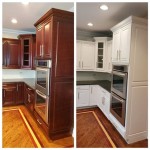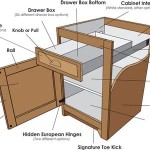Distressing Kitchen Cabinets With Stain: A Comprehensive Guide
Distressing kitchen cabinets is a popular method for achieving a rustic, vintage, or farmhouse aesthetic. Although paint is frequently employed, distressing with stain offers a unique approach, revealing the wood's natural grain while adding depth and character. This technique works particularly well with cabinets made from wood with prominent grain patterns, such as oak, ash, or hickory. The process involves strategically removing or altering the stain to simulate the wear and tear of age, creating a time-worn appearance.
While distressing with stain can appear complex, it is a manageable project for the average homeowner with the right tools, preparation, and understanding of the necessary steps. The beauty of this method lies in its adaptability; the degree of distress can be tailored to individual preferences, ranging from subtle aging to more dramatic, weathered effects.
Preparing Cabinets for Staining and Distressing
Proper preparation is crucial for achieving a successful and long-lasting distressed finish. Neglecting this stage will likely result in a substandard outcome and potentially require additional work to rectify imperfections. The preparation process fundamentally involves cleaning, sanding, and, if necessary, priming the cabinets.
The initial step is to remove all hardware, including knobs, pulls, hinges, and any other decorative elements attached to the cabinets. This prevents these elements from interfering with the sanding and staining process and ensures a clean, consistent finish. All cabinet doors and drawers should be removed from the frames for easier accessibility and handling.
Next, thoroughly clean the cabinets to remove any grease, dirt, or existing finishes. A strong degreaser is recommended, particularly in kitchens where grease buildup is common. After cleaning, rinse the cabinets with clean water and allow them to dry completely. This step is essential to ensure the stain properly adheres to the wood surface.
Sanding is the next crucial step. Begin with a coarser grit sandpaper (around 120-grit) to remove any existing finish, smooth out imperfections, and create a slightly rough surface that will allow the stain to penetrate the wood. After the initial sanding, switch to a finer grit sandpaper (around 220-grit) to refine the surface and remove any scratches left by the coarser grit. Sand in the direction of the wood grain to avoid cross-grain scratches. Dust the cabinets thoroughly after sanding to remove all sanding residue.
If the cabinets are made of unfinished wood or if the existing finish is particularly difficult to remove, a wood conditioner might be necessary. Wood conditioner helps to ensure the stain is absorbed evenly, preventing blotchiness and creating a more consistent color. Apply the wood conditioner according to the manufacturer's instructions, and allow it to dry completely before proceeding with the staining process. In cases where the existing finish is very dark or difficult to sand off completely, priming the cabinets with a stain-blocking primer will provide a uniform base for the stain and prevent the old finish from bleeding through.
Applying the Stain and Distressing Techniques
Once the cabinets are properly prepared, the staining process can begin. Selecting the right stain is important. Gel stains are often preferred for cabinets because they are less likely to drip and provide a more even color. Choose a stain color that complements the existing décor and the overall desired aesthetic.
Apply the stain evenly using a brush, rag, or foam applicator. Follow the manufacturer's instructions for application techniques and drying times. Allow the stain to penetrate the wood for the recommended time, and then wipe off any excess stain with a clean cloth. This step is crucial for controlling the depth of color and ensuring a consistent finish. Applying multiple thin coats of stain is generally preferable to applying one thick coat, as it provides better control over the color intensity.
The distressing process is where the character and uniqueness of the finish are created. Several techniques can be used to achieve a distressed look, and it is common to combine multiple techniques for a more layered and authentic appearance. Some common distressing methods include:
Sanding:
This is the most basic distressing technique, involving sanding away the stain in specific areas to reveal the wood underneath. Focus on areas that would naturally experience wear and tear, such as edges, corners, and around knobs and pulls. Use different grit sandpapers for varying degrees of distress.Dry Brushing:
This technique involves lightly applying a contrasting paint color over the stained surface with a dry brush. The paint should be applied sparingly, allowing the stain to show through in some areas. Dry brushing is particularly effective for highlighting details and adding texture.Glazing:
Applying a glaze over the stained surface adds depth and dimension. Glazes are typically applied with a brush or rag and then wiped away to leave a residue in crevices and corners, accentuating details and creating a weathered appearance.Using Chains, Hammers, and Other Tools:
For a more dramatic and rustic look, tools such as chains, hammers, screwdrivers, and sandpaper can be used to create dents, scratches, and other imperfections in the wood. These imperfections should be applied strategically and purposefully to mimic natural wear and tear.Steel Wool:
Using fine-grade steel wool can gently remove stain from edges and raised areas, creating a subtle worn effect.
Experimenting on a spare piece of wood is recommended before applying distressing techniques to the cabinets. This allows the user to practice and refine their technique before working on the actual project. Gradually distress the cabinets, stepping back frequently to assess the overall effect and ensure the desired look is being achieved. It is always easier to add more distress than to remove it.
Sealing and Protecting the Distressed Finish
Once the stain has dried completely and the distressing is complete, it is essential to seal and protect the finish. This will not only enhance the durability of the cabinets but also prevent the stain from fading or chipping over time. Applying a clear topcoat is the most common method for sealing the distressed finish.
Water-based polyurethane is a popular choice for topcoats due to its durability, ease of application, and low odor. Oil-based polyurethane offers a slightly more durable finish but has a stronger odor and requires more time to dry. Choose a topcoat with a sheen that complements the desired aesthetic. Matte or satin finishes are often preferred for distressed cabinets, as they enhance the rustic look and minimize reflections.
Apply the topcoat evenly using a brush, roller, or spray gun. Follow the manufacturer's instructions for application techniques and drying times. Multiple thin coats of topcoat are preferable to one thick coat, as they provide better protection and reduce the risk of drips or runs. Lightly sand the surface between coats of topcoat with fine-grit sandpaper (around 320-grit) to create a smooth and even finish.
Allow the topcoat to dry completely before reinstalling the hardware and reattaching the cabinet doors and drawers to the frames. Be careful when handling the finished cabinets to avoid scratching or damaging the finish. Consider adding felt pads to the bottom of the cabinet doors and drawers to prevent them from rubbing against the frames and causing wear and tear over time.
Maintaining the distressed cabinets involves regular cleaning with a mild soap and water solution. Avoid using harsh chemicals or abrasive cleaners, as these can damage the finish. Periodically inspect the cabinets for any signs of wear and tear, such as scratches or chips, and touch up the finish as needed. Applying a fresh coat of topcoat every few years will help to maintain the durability and appearance of the distressed cabinets.
Successfully distressing kitchen cabinets with stain involves a combination of careful preparation, skillful application, and diligent sealing. By following these steps and understanding the various techniques involved, homeowners can achieve a beautiful and unique finish that adds character and charm to their kitchens.

Distressed Worn Looking Kitchen Cabinet Designs

Distressed Kitchen Cabinets How To Distress Your

Rustic Style Really Brings The Excitement To Room It Works Great With Farmhouse And Distressed Kitchen Cabinets

Meuble De Cuisine Patiné Distressed Kitchen Cabinets Painting

Staining Kitchen Cabinets Pictures Ideas Tips From

Cabinet Distressing Techniques Edgewood Cabinetry

Stress Less With Distressed Cabinets

July 2024 Distressed Kitchen Cabinets Black

Distressed Kitchen Cabinets Tips To Achieve This Antiquing Effect The Blog

Distressed Kitchen Cabinets How To Distress Your
Related Posts








